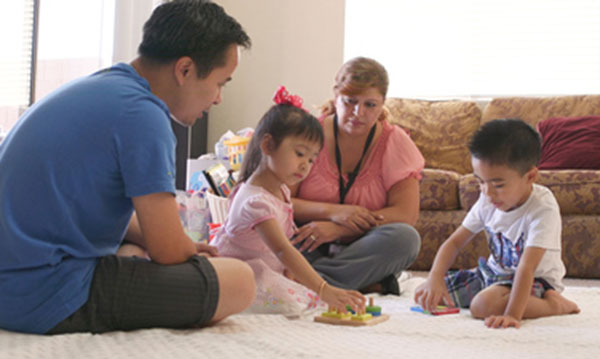 "The research question about home visiting is not 'does it work?' but 'for whom does it work, under what circumstances.' " – Jones Harden et al. (2012)
"The research question about home visiting is not 'does it work?' but 'for whom does it work, under what circumstances.' " – Jones Harden et al. (2012)
Research on home visiting programs and the EHS home-based program option demonstrates that home visiting is a complex endeavor. Positive outcomes of child development, family well-being, positive parenting, health, school success, and economic stability appear in different degrees, in different program models, for different populations. Nonetheless, home visiting is proving to be an effective form of early intervention and parenting support through numerous, rigorous evaluation studies.
In 1996, the U.S. Department of Health and Human Services (HHS) launched a large-scale evaluation of the new EHS program. HHS randomly assigned to participate qualifying families at 17 sites nationally and looked at their social, psychological, developmental, and academic outcomes compared to a matched control group. Families in the control group were able to receive any community services available to them. The evaluation followed families over five time points, according to the child's age: 14 months, 24 months, 36 months, pre-kindergarten, and fifth grade. Below are some of their findings.
Family Demographics and Family Engagement
"Mental health was related to general and specific engagement, suggesting that home visitation may be effective in addressing underlying mental health issues of parents but also illustrating that the operative component is whether the home visitor is able to successfully engage the mother." – Raikes et al. (2006)
Family characteristics predicted family engagement in home visiting programs:3
- Teens and single mothers get somewhat fewer services.
- Mobile families have a shorter duration in the program.
- Families of a child with a disability stayed longer and were more engaged.
- Non-English-speaking Hispanics were more engaged.
- African-Americans received fewer child-focused experiences.
- White families received more services but were not more engaged.
- Families with more risk factors received fewer child-focused experiences.
Child Outcome Findings
Child-focused experiences are the best indicator of positive school readiness outcomes.
"Certainly, quality of engagement and child focus in the visit are inextricably bound to quantity of visits and these features can only occur within the context of regular home visits." – Jones Harden et al. (2012)
At 36 months for EHS children, the home-based model had positive effects on:
- Child engagement with the parent in semi-structured play
- The likelihood of an IEP
- Standardized cognitive test scores
- Emergency room visits due to accident or injury
- Cognitive and language development
- Parental support for cognitive and language development
- Home environments, which were robustly related to the extent of child-focused activity during the home visit
- Compliance with immunization and well-child visits
- Ongoing contact with the medical home
- Ongoing follow-up and support with children with special needs1, 2
At pre-kindergarten, EHS children in the home-based model had positive effects on:
- Child engagement during parent-child play
- Social behavior problems
- Positive approaches toward learning
- Standardized test scores on problem-solving
- Attending a formal preschool program1
1. Jones Harden, B., Chazan-Cohen, R., Raikes, R., and Vogel, C. "Early Head Start Home Visitation: The Role of Implementation in Bolstering Program Benefits." Journal of Community Psychology 40:4 (2012): 438–455 (wileyonlinelibrary.com/journal/jcop). DOI: 10.1002/jcop.20525.
2. Early Head Start Research and Evaluation Project (EHSRE), 1996–2010: Project Overview. Available at http://www.acf.hhs.gov/programs/opre/research/project/early-head-start-research-and-evaluation-project-ehsre-1996-2010
3. Raikes, H., Green, B., Atwater, J., Kisker, E., Constantine, J., and Chazan-Cohen, R. "Involvement in Early Head Start Home Visiting Services: Demographic Predictors and Relations to Child and Parent Outcomes." Early Childhood Research Quarterly 21 (2006): 2–24 .
Read more:
Resource Type: Article
National Centers: Early Childhood Development, Teaching and Learning
Last Updated: September 27, 2023